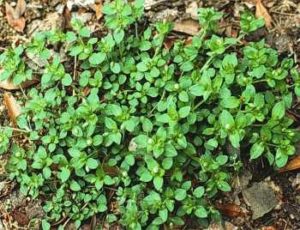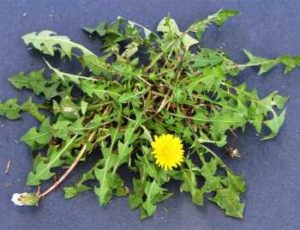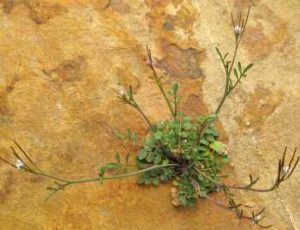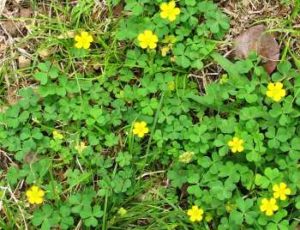IDENTIFY LAWN WEEDS
BROADLEAF WEEDS*
Bedstraw

Bedstraw is a winter annual. The leaves of bedstraw are formed in whorls containing 6 – 8 leaves around square stems. The leaves are narrow to lanceolate in shape with bristles along the edges. Spines at the base of leaves allow bedstraw to cling to objects. Bedstraw is more of a problem in high-mowed or infrequently mowed areas, such as those found in roughs or along fencerows. It is most competitive in shady environments. It prefers moist soils, high in nutrients and organic matter. Once this annual has died, it turns brown and decomposes very quickly. Regular mowing at lower heights will usually control bedstraw. If bedstraw is growing in a shaded area, thinning out trees is recommended if possible. Bedstraw is fairly easy to remove by hand where only a few weeds are growing.
Black Medic

Black medic is normally a summer annual, but can act as a perennial in some conditions. It has a taproot, and spreads low to the ground, but it does not root from nodes on the stems. Black medic is more active on soils low in nitrogen fertility. Black medic produces viable seed under normal mowing conditions. Black medic is found throughout the continental United States. Good turf management practices, including a balanced nitrogen/phosphorus fertilization program, will encourage a dense stand of turf and make it difficult for black medic to persist.
Bristly Mallow

Bristly mallow is a creeping perennial with shiny, light green leaves which alternate on the stem. Bristly mallow will root at nodes along the underside of the stems which appear as knobs. The flower of bristly mallow is an orange-red in color and appears in late spring to early summer. Bristly mallow spreads by seed and by stoloniferous stems. Bristly mallow is found in the lower Piedmont and coastal plain region of the Southeast, from Virginia to Florida. It can also be found in the gulf states west to Texas. Bristly mallow is found on moist to dry disturbed soils. Physical removal of the stems should be accomplished before seed is produced in the early summer. Be sure to remove all of the creeping rooted stems.
Carpetweed

Carpetweed is a summer annual with smooth prostrate branching stems forming circular mats. The leaves are light green in color, lanceolate in shape, being widest in the middle of the leaf and narrow at the tip and base. The leaves form in whorls containing 3 – 8 leaves. The flowers are white, contain five petals, and form clusters of two to five flowers. Carpetweed spreads by seed. Carpetweed is found throughout most the North America. Carpetweed is a summer annual that germinates much later than other summer weeds, and may be missed by early treatments. Once it germinates, it grows very quickly. It does best on thin turf. It can usually be found in new spring plantings that have not matured prior to entering the summer. Due to its low prostrate growth habit, it can be missed during mowing. It prefers moist rich soils, but can establish on drier sandy soils.
Chamberbitter

Chamberbitter is a warm season annual. The stems of chamber bitter are upright and grooved. The leaves are small and have smooth margins which are arranged oppositely on branchlets. Flowers are inconspicuous and form in warm weather. The fruit of chamber bitter is green and form on the underside of the branchlets. The seed explodes and spreads seeds in the surrounding area. Chamber bitter reproduces from seed. Chamber bitter is found from Texas to Florida and in the Tropics. Chamber bitter grows in turf, nurseries and other disturbed areas. Hand pull when possible.
Common Chickweed

Common chickweed is a shallow fibrous rooted winter annual which grows in moist shaded areas. The leaves are small, smooth, pointed at the tip and elliptic in shape. Chickweed adapts well to different mowing heights. The flowers of common chickweed are white, small star like with 5 notched petals. Common chickweed spreads by seed. Common chickweed is found throughout the United States except in the Rocky Mountains. Common chickweed thrives in cool, moist areas. Growing conditions can be made less favorable by lightening the soil or otherwise improving drainage, especially in shady areas. Heavy, constant shade should be lightened as well where possible. Shady areas should be planted with turfgrass species which do well in the shade and which will provide maximum competition to weed species which invade shady areas.
Dandelion

Dandelion is a winter perennial. The dandelion has a thick fleshy taproot which often branches. New plants come from the root and root segments. Both the leaves and flower stems contain a white milky fluid. The flowers are yellow and are individual stems. The seeds are brown with the tip containing white hairs. The yellow flower will turn to a white globular puffball. The seeds are disseminated by wind. Dandelions spread by both seed and stems from the root. Dandelions can be physically removed, but it is very important to remove the taproot, in its entirety if possible, as new plants can sprout from root sections. Good insect and disease control and a sound fertility program will help to prevent the open spaces that allow dandelion seeds to take root.
Dayflower

Dayflower is an annual with multiple branches that spread by taking root from nodes along stems. Stems are smooth with lance shaped leaves in sheaths having a few soft hairs. Flowers have three blue petals, two of which are partly fused. Flowers last one day, giving the plant its common name. Dayflower reproduces from seed and from nodes along stems. Stem fragments will also reproduce. Dayflower prefers rich, moist soil conditions. Dayflower is found from Massachusetts west to Kansas and south to Florida and Texas. Dayflower plants can be physically removed when small. Care must be taken to remove all stem fragments to avoid reestablishment.
Dollarweed or Pennywort

This is a summer perennial weed. The leaves of dollarweed or pennywort are round in shape, approximately 1-inch in diameter. The dark green leaves are glossy, with scalloped edges and are on long slender petioles. The flower is small with 5 white petals and forms in clusters on the end of long stems. Dollarweed or pennywort spreads by seed and rhizomes. The weed is found along the Atlantic coast from Maine to Florida and westward to Minnesota, Texas, Utah, Arizona and California. Avoid excess moisture. Dollarweed or pennywort thrives in wet areas. Improved drainage may help to prevent infestation.
Dovefoot Geranium

Dovefoot geranium is a biannual plant. Dovefoot geranium has slender, weak hairy stems which branch and spread across the surface of the soil. The leaves are palmately lobed. Dovefoot geranium spreads by seeds which germinate in fall into the early spring. Bright dark pink to red violet flowers are present in late spring. Dovefoot geranium is found throughout the United States, but is more prevalent in the southeast. Dovefoot geranium is a weed of lawns and landscapes. It can also be found in fields and roadsides. It grows best on nutrient-poor soils, deficient of moisture. Dovefoot geranium can be pulled out prior to seed production. Fertilize with a balanced fertility program to keep the turf thick. Irrigate on a regular basis to avoid drought stressing the turf
Ground Ivy

Ground ivy is a creeping winter perennial. The leaves are round to kidney shaped with round toothed edges. It is usually found in moist shaded areas, but also tolerates sun very well. Ground ivy will form dense mats which can take over areas of turfgrass. The flowers of ground ivy are blue to lavender and grow in clusters. It usually flowers in the spring. Ground ivy spreads by stolons and sometimes by seed. Ground ivy closely resembles common mallow. Ground ivy is more common in the East, but can be found throughout the United States. Ground ivy is a highly aggressive plant species which will quickly invade turf areas from adjacent properties or ornamental planting areas. Management attempts based on physical removal of ground ivy plants require constant vigilance and careful attention. The stem runners can be several feet long, and the failure to remove all plants along the entire length will result in re-infestation. Additionally, all planted ornamental beds must be cleaned out as well to avoid ground ivy spreading from these areas. If an adjacent property is not properly maintained and is infested with ground ivy, property perimeters will require constant attention. Maintenance of dense stands of turfgrass with good insect and disease control and a sound fertility program will help prevent major infestations.
Hairy Bittercress

Hairy bittercress is a winter or summer annual depending on its location. It initially forms a basal rosette. The initial true leaves are heart shaped, followed by leaves which contain 2 – 4 alternating leaflets. The surface of the leaves is often hairy. Hairy bittercress forms stems that are smooth and erect, usually branched at the base with few leaves. Hairy bittercress spreads by seed. Hairy bittercress can have multiple generations per year. Hairy bittercress is found from Maine to Florida, west to Nebraska and Texas. Hairy bittercress is an annual weed which is found on wet disturbed areas. It does best on sandy to organic soils. It can be found in landscapes, turf and in container plants. Allow soils to dry or correct drainage to prevent soils from remaining moist.
Henbit

Henbit, a member of the mint family, is an upright winter annual that blooms in the spring. The leaves are rounded on the end with rounded toothed edges that grow opposite one another on square stems. Henbit can grow from 4- to 12- inches tall on weak stems. The flowers of henbit are purple, tubular shaped and form in the whorls of the upper leaves. Henbit spreads only by seed and is generally not a problem in dense, vigorous turfgrass sites. Henbit is found throughout the United States. Henbit can be highly competitive in newly seeded areas and thin or dormant turf. Henbit thrives in cool, moist areas. Growing conditions can be made less favorable by lightening the soil or otherwise improving drainage, especially in shady areas. Heavy, constant shade should be lightened as well where possible. Shady areas should be planted with turfgrass species which do well in the shade and which will provide maximum competition to weed species which invade shady areas.
Oxalis or Yellow Woodsorrel

Yellow woodsorrel, also known as oxalis, is a summer annual, that can be perennial in some areas. Yellow woodsorrel grows on weak stems that branch at the base and may root at the nodes. Although sometimes mistaken for clover when not in flower, the leaves differ from clover in that they are distinctly heart shaped. The yellow woodsorrel flower is yellow with five petals and occurs in clusters. Yellow woodsorrel spreads by seeds which burst from the pods at maturity and may be scattered several feet. Yellow woodsorrel is found throughout the United States. Since seeds may be projected several feet when seed pods mature, it is important to keep oxalis out of adjacent ornamental and flower beds as well as removing from turf areas. Dense, vigorous cool-season turf areas will resist infestation. Physical removal of single plants can be easily accomplished. Follow good turf management practices including disease and insect control and proper fertilization.
Plantain

Broadleaf plantain is a shallow mostly fibrous rooted perennial. The leaves which develop in a rosette are large oval shaped with predominant veins. The main growth period for broadleaf plantain is from June through September. The seed head is described as a rat-tail like seed head with flowers along the upper half of the seed head. Broadleaf plantain spreads by both seed and shoots from the roots. Broadleaf plantain is found throughout all of the United States. Broadleaf plantain can be mechanically or physically removed. Care should be taken to assure that roots are thoroughly removed. Close mowing prevents seed head formation and helps to prevent spread. Good turf density is important as broadleaf plantain competes by shading other plant species with its broad rosette of leaves. Good insect and disease control will help to prevent the open spaces that broadleaf plantain will fill. Good fertility and proper soil pH will help to prevent infestations.
Purselane

Purslane is a summer annual with prostrate growth from a taproot and fibrous surface roots. The leaves are thick and waxy, resembling a jade plant. The leaves usually alternate, with a cluster at the tip of the stem. Stems are thick, red in color, and branch out from a central point, forming a mat up to 1-foot in diameter. Purslane flowers from May to November and spreads by seeds, which germinate in the spring, or by stem fragments. Purslane is found throughout the United States. Dense, vigorous cool-season turf areas will resist infestation. Physical removal of single plants can be easily accomplished, although it is important to eliminate all stem fragments. Follow good turf management practices including disease and insect control and proper fertilization. Purslane can become a problem in newly seeded areas. It is best to avoid attempting to establish new stands of cool-season turfgrass in the spring. Fall seedling establishment will not be threatened by purslane aggression.
Spotted Spurge

Spotted spurge is a summer annual. The flower of spotted spurge is small and green in color. It germinates in mid spring and flowers from June to September. Spotted spurge reproduces from seed. Spotted spurge is found throughout the United States. Spurge can tolerate compact soil conditions and is often found invading high traffic or otherwise stressed turf areas. It is generally not found in dense, healthy stands of turfgrass, so good maintenance practices constitute good prevention of infestation. Where high traffic is the problem, core aerate and attempt to divert traffic where possible. Physical removal of single plants can be easily accomplished. Follow good turf management practices including disease and insect control and proper fertilization.
White Clover

White clover, found throughout the United States, is a shallow rooted winter perennial legume which spreads by stolons or above ground runners. Leaves may contain a white ‘watermark’. White clover is adapted to many soils but tends to grow best in soils that are moist and low in nitrogen. The flowers are an aggregate of 20 to 40 individual flowers. They are white in color, although some have a slight pink tint. White clover flowers from May through September. Preventive practices can discourage clover infestation. Mechanical or physical removal is not recommended, as stolons may break and sprout with the potential to increase, rather than decrease, the infestation. If the turf is kept under very close mowing conditions (6-8 mm), pluggers may be used effectively for physical removal. Good turf management practices, including good liming and a nitrogen fertilization program, will encourage a dense stand of turf and make it difficult for clover to become established.
GRASSY WEEDS: treated through prevention only*
Annual Bluegrass

Small tufted to clumped, yellow-green winter annual. Leaf blade smooth on both surfaces, with two distinct, clear lines, one on each side of the midrib, blades often wrinkled (wavy). Light green to whitish spikelets that lack cottony hairs, are arranged on branches, one to two per node, in dense to open flower clusters. Fruits throughout life cycle with majority of seedheads formed during spring. Perennial biotypes occur in moist, closely mowed areas, such as golf course greens. Compared to annual bluegrass, the perennial biotypes generally are darker colored, more prostrate growing, produce few seedheads, and often form patches from short stolens. Control options/strategies change constantly. Check with your local state turfgrass specialist for the latest recommendations.
Crabgrass

Crabgrass is a summer annual that germinates when soil temperatures reach a consistent 55 degrees F and is generally killed at the first frost. Crabgrass is light green in color, coarse bladed and will root at the nodes when they touch the ground. A single crabgrass plant can produce up to 700 tillers. It is a bunch type grass. A crabgrass plant can produce 150,000 seeds. Crabgrass needs warm soils and sunlight to germinate. Crabgrass is found throughout the United States. A slightly raised mowing height may help prevent the establishment of crabgrass by providing shade from sunlight. When crabgrass is going to seed, lower the mowing height and collect clippings to prevent seed establishment.
Crowfootgrass

Yellow-green tufted summer annual with upwardly bent stems rooting at the lower notes. Leaves with Row of hairs extending outward from the margin along the lower portion of blade. Rolled vernation. Seedhead spikelets arranged on two to five “fingers” radiating from a central point at tip of the stem. Outer tips of fingers extended, resembling claws, giving seedhead a “crowfoot” appearance. Fruits midsummer until frost. Found in disturbed sites, especially sandy soils. Propagates from seed. Improve turf growing conditions and follow recommended fertilizer, watering, and mowing practices.
Dallisgrass

Dallisgrass is a warm season coarse perennial which is light green in color. The leaves are rolled in the bud, flat and wide (1/2″). The seedhead contains 3 – 6 spikes, with seeds on both sides of the spike. Dallisgrass can form short thick rhizomes, but spreads upright in clumps. This highly invasive plant germinates in soil temperatures of 60 to 65 degrees F and thrives in the hot humid conditions of the southern states. Dallisgrass is found throughout humid southern United States, ranging from the mid-Atlantic states south and west to Tennessee. Dallisgrass may be physically removed by hand pulling.
Goosegrass

Goosegrass is a prostrate-growing summer annual. The leaves are folded in the bud. Goosegrass grows in a clump with the base of the leaves being distinctly white to silver in color. Goosegrass contains hairs only at the base of the leaf. Goosegrass seedheads contain 3 -7 spikes that form at the tip of the seed stalk. Goosegrass spreads by seeds that germinate later in the season than other annual grasses. Goosegrass is found in the United States from the transition zone south. Goosegrass is highly competitive during hot summers, and can out-compete desirable grasses where soil is compacted. Core aeration should be provided to improve soil conditions for desirable grasses. Single plants can be physically removed with a knife. Do not seed when soil and weather conditions are appropriate for the germination of goosegrass (60 to 65 degrees F). A slightly raised mowing height may help prevent its establishment by providing shade from sunlight.
Nutsedge

Sedges have triangular stems with waxy grass-like leaves which alternate. Sedges are not grass plants, but seedlings may be mistaken for grass. The leaves on sedges are waxy and have an upright growth habit and a prominent midrib. Sedges have underground root systems containing rhizomes and underground tubers which accomplish most of the reproduction. On yellow nutsedge, the tubers (nutlets) form at the end of whitish rhizomes. Purple nutsedge forms chains of tubers along brownish rhizomes. The flowers of yellow nutsedge are yellowish; the seedhead color of purple nutsedge is red-purple to brown. Both seedheads are on triangular stems. Both spread mainly by germinating underground tubers, which are the only part of the plant that over-winters. A yellow nutsedge tuber can produce 1,900 plants and 7,000 new tubers in a single growing season. Sedges do well where soil has poor drainage. Yellow nutsedge is found throughout the United States; Purple nutsedge is primarily found in the warm humid southern states. Improve drainage through core aeration and lightening the soil. Keep turfgrass sites free from stress and vigorously competitive with sedges. Keep mowing heights as low as possible in spring and early summer when sedges are most actively growing. Fertilize cool-season grasses in the fall after frost.
*This information was compiled using the weed identifying tool on: http://www.weedalert.com/

